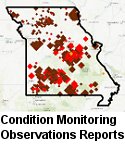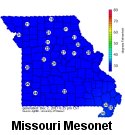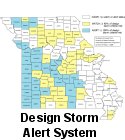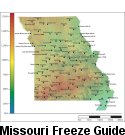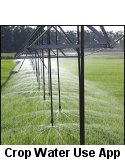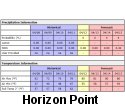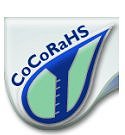
The Missouri Climate Program - A Historical Review
Wayne L. Decker and Steve Qi Hu(Revised January, 2009) Pat Guinan
Early Developments
In 1877 Professor Francis E. Nipher of Washington University in St. Louis recruited observers from sections of the state of Missouri for the purpose of collecting measurements of rainfall and temperature. At the outset the observers were required to purchase their own rain gauge. The type of gauge identified by Professor Nipher was the "Iowa gauge." Some of the observers also acquired Green's thermometers or other type of thermometers.
In 1882 a bill was introduced in the Missouri Legislature to appropriate two thousands dollars to establish a state weather service. According to Professor Nipher,
"The consideration of this bill furnished an occasion for mirth to some members of the body, but failed to awaken any general interest. This experience was, in fact, so depressing that no further attempt has been made in that direction."
By 1887 the Missouri climate network consisted of 77 stations with a very good geographic distribution across the state. A summary of the ten-year observation was reported in the Transactions of the St. Louis Academy of Science in 1888. The reported rainfall pattern averaged over this ten-year period is remarkably similar to the distribution of the modern thirty-year normals for the state.
The Section Center in Missouri
Soon after the establishment of a federal weather service in 1890, an office in each state was designated as the "Section Center." Apparently the duty assigned to these Centers was to supervise the cooperative network and to publish the observations in "Climatological Data." There is no record of any further service being accomplished at the Missouri Section Center.
The Missouri Section Center was first located in Columbia, Missouri and the Director was A. E. Hackett. He continued in that position until 1917 when the position passed to George Reeder. In 1932, O. R. Rogers became a temporary replacement serving from May through September.
In October 1932, the Missouri Section Center was moved to St. Louis and remained there until the mid-1950's. There were three Directors with short tenures in the first ten years in St. Louis; Roscoe Munn, W. J. Maxom and H. C. Gross. In May of 1943, W. F. Wahgren became the last Director of the Missouri Section Center and he served until May 1954.
The function of the Missouri Section Center was well established by the 1940's. The cooperative observers mailed their observing forms to St. Louis at the end of each month. The records were checked manually by clerical personnel and tables were prepared for Climatological Data. These data were hand set on a small printing press; and the publication was printed after the preparation of the text of a monthly summary. The mailing was completed as the final step and the processing of the next month's data began.
In 1947 and 1948, a "new" system of data processing was established nationwide. A Regional Weather Records Processing Center was established in Kansas City, MO for the Central Region of the Weather Bureau. The observers' forms for Missouri were sent to Kansas City where they were placed onto "punched cards." The records and the tables for Climatological Data were examined by clerical "experts" with the assistance of tabulating machines. The publication was printed by photo-off-set processing.
The period following 1948 was a traumatic time at the Missouri Section Center! The new system of data processing was supposed to releasing time for the Director and his staff to accomplish other important climatological functions. But the facts were that many of the clerical staff were transferred to the regional processing center, and neither the remaining staff nor the Director were provided guidance or training in climatological services.
The University of Missouri's Climate Program
In 1947, The College of Agriculture at the University of Missouri-Columbia established a climate project in the Agricultural Experiment Station. The project was instigated by Dean Emeritus M. F. Miller and Associate Dean Samuel Shirkey. A cooperative agreement was negotiated with the U.S. Weather Bureau to place the climate records for selected Missouri weather observing stations onto punched cards. Harold McComb, Meteorologist-in-Charge of the Columbia Weather Bureau Office, was designated as the federal cooperator. Through the efforts of Mr. McComb observer forms were checked and punched onto cards at a newly established processing center on campus. Except for the time devoted by McComb and his staff the effort was paid out of University resources.
In 1948-49, the University of Missouri-Columbia established a professional position in climatology. Dr. Wayne L. Decker accepted the position as Assistant Professor and began his tenure at the University on September 15, 1949. During the early 1950's the card punching of climatic records for machine processing continued at the University of Missouri. Early in 1951 a series of climate related bulletins was published by the Missouri Agricultural Experiment Station. These bulletins not only described the patterns of precipitation and temperature across the state but also presented "risk statistics" which were intended to assist in management of the agricultural enterprise in the state.
In 1954, in response to a major drought in the Midwest, a regional project for study of climatic variabilities and risk to agriculture was established in the North Central Region of Agricultural Experiment Stations. This regional program has continued for the past forty years. The University of Missouri-Columbia has been the major contributor to these climate studies.
State Climatologist for Missouri
Under the imaginative leadership of Helmut Landsberg of the U.S. Weather Bureau's Central Office, a national program for climatological services was established in the early to mid-1950's. In 1956, James Mc Quigg was assigned to Columbia as the new State Climatologist. Originally Mc Quigg served a dual function as the Meteorologist-in-Charge of the Weather Bureau Airport Station and the State Climatologist.
Mc Quigg was not only very energetic but also a very capable climatologist. During the period from 1956 to 1964 he combined his duties with graduate study to win both an MS and Ph.D. degrees at the University of Missouri-Columbia. His graduate research focused on the use of climatic data and information in economic decisions.
As the State Climatologist Mc Quigg collaborated with University colleagues to continue the publication of papers and bulletins dealing with the climatic risks in agricultural management. He also became known throughout the U.S. and the world for his expertise in the economic impacts of weather and climate. This reputation led him into the national and international scientific and policy issues. In 1970, he was designated as a Research Meteorologist for the Environmental Data Service, NOAA. As a federal researcher his work remained on campus of the University of Missouri-Columbia.
Warren Wisner was appointed State Climatologist for Missouri in 1970. He continued the cooperative work in climatology with the University of Missouri. Then in 1973 the "death letter" was received from the Administrator of NOAA ending the nationwide program for State Climatologists.
Post 1973 Missouri State Climate Program
In the letter to the Governors of the states the Administrator of NOAA suggested that the service programs for climatology was really a "state function" and invited each state to develop their own programs. The invitation was received with the same enthusiasm as the proposal suggested to the Missouri Legislature by Professor Nipher ninety years earlier. In order to keep the issue alive Dean Elmer Kiehl of the College of Agriculture of University of Missouri-Columbia requested that Dr. Wayne L. Decker be designated as the State Climatologist for Missouri. A letter was received from Governor Christopher Bond to that effect.
The next 20 years was a period of low activity as far as the state climate program was concerned. Other aspects of climatology dealing with field studies of energy balances of various vegetative surfaces became the major national and international interest. During this period there was an attempt or two to interest collaborations with state environmental agencies in developing joint climatological programs with the State Climatologist. These also received the same response as Professor Nipher's effort in 1882.
In spite of the failure of a climate center to gain recognition by the infrastructure of state government in Missouri there were several initiatives which developed segments of a climate information service.
- By 1989, a clientele was developed among the researchers in the Agricultural Experiment Station of University of Missouri-Columbia in support of climate information for individual research projects. With the help of Associate Director William Pfander a half-time position was established as Experiment Station Climatologist.
- The Commercial Agriculture Program sponsored by University of Missouri Extension is a program to foster research and out-reach for the commercial farms in Missouri. Specialized weather stations with automated microprocessors have been established at locations where the commercial farm operations are conducted.
- The Midwestern Climate Center, located in Champaign, Illinois, has provided assistance in development of some collaborative climate research and out-reach programs in Missouri over the past several years.
The Missouri Climate Center
As the result of a recommendation in the final report of the Missouri Commission on Global Climate Change and Ozone Depletion, the Missouri Legislature in 1994 appropriated funds to establish a climate center at the University of Missouri-Columbia. In July, 1995. Dr. "Steve" Qi Hu was designated as the State Climatologist for Missouri and assigned in early 1996 as the Director of the Missouri Climate Center. In March 1999, Dr. Adnan Akyüz took the responsibilities for the Missouri State Climatologist and remained in this position through 2004. Dr. Patrick Guinan was appointed State Climatologist and Missouri Climate Center director in March 2005.
The Center continues the climate service tradition of the state climate programs while adding new dimensions of global and regional climate change researches to the existing programs. The funding for the Center is from research grants and the support for 1995-1996 has been from the Missouri Department of Conservation and Department of Natural Resources.
If you have any ideas and suggestions on how we may improve the center's function and role and better serve the center's proponents, including the natural resources monitoring and research, we will be happy to hear them. You may contact us by telephone at (573) 882-5908 or send suggestions/comments to Dr. Pat Guinan


